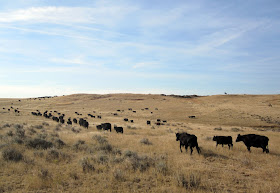Here are some other pictures from last weekend at my uncles. This week I traveled just over 1,000 miles (I added it all up). Because of this I am attempting to stick with a strict no traveling rule for the weekend. We will see how successful I am.
 My cousin loading cows.
My cousin loading cows.
 Cattle just south of my uncle's place. Those far trees are his bull pasture.
Cattle just south of my uncle's place. Those far trees are his bull pasture.
 My uncles brand in the end of the stove used to heat branding irons.
My uncles brand in the end of the stove used to heat branding irons.
 Duke, who has suffered two broken front legs in his lifetime.
Duke, who has suffered two broken front legs in his lifetime.
 Turk (left) and Butthead (yep, that's his name) in front of the barn at my grandma's
Turk (left) and Butthead (yep, that's his name) in front of the barn at my grandma's
 Patiently waiting
Patiently waiting

 Some the last fall leaves in the black hills
Some the last fall leaves in the black hills

 My brother Kyle. The red beard is for his halloween costume. He is going as Luigi...I think.
My brother Kyle. The red beard is for his halloween costume. He is going as Luigi...I think.
If he looks like he's in pain, it's because he is. A couple weeks ago he almost broke his foot when a bunch of calves pinned him under a gate in our cattle pot. After knocking the heavy gate on top of him, about 6 of the 500+ plus pound calves ran over the gate...and him. He's missing a little skin and has some good bumps on his head to go with the sore foot.
Now, this foot probably wouldn't still be hurting, except that in true guy (especially ranch guy) form he didn't listen to the doctor tell him to keep off it, ice it etc...and has been going full tilt since about 2 days after it happened. (Insert a sisterly tsk tsk here)
 My cousin loading cows.
My cousin loading cows. Cattle just south of my uncle's place. Those far trees are his bull pasture.
Cattle just south of my uncle's place. Those far trees are his bull pasture. My uncles brand in the end of the stove used to heat branding irons.
My uncles brand in the end of the stove used to heat branding irons. Duke, who has suffered two broken front legs in his lifetime.
Duke, who has suffered two broken front legs in his lifetime. Turk (left) and Butthead (yep, that's his name) in front of the barn at my grandma's
Turk (left) and Butthead (yep, that's his name) in front of the barn at my grandma's Patiently waiting
Patiently waiting
 Some the last fall leaves in the black hills
Some the last fall leaves in the black hills
 My brother Kyle. The red beard is for his halloween costume. He is going as Luigi...I think.
My brother Kyle. The red beard is for his halloween costume. He is going as Luigi...I think.If he looks like he's in pain, it's because he is. A couple weeks ago he almost broke his foot when a bunch of calves pinned him under a gate in our cattle pot. After knocking the heavy gate on top of him, about 6 of the 500+ plus pound calves ran over the gate...and him. He's missing a little skin and has some good bumps on his head to go with the sore foot.
Now, this foot probably wouldn't still be hurting, except that in true guy (especially ranch guy) form he didn't listen to the doctor tell him to keep off it, ice it etc...and has been going full tilt since about 2 days after it happened. (Insert a sisterly tsk tsk here)









































